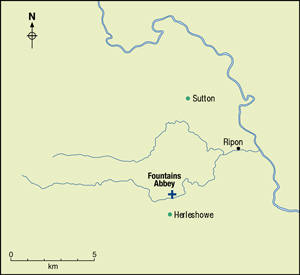 |
 |
 |
 |
 |
 |
 |
|
Fountains Abbey: History
Fountains Abbey: Buildings
|
The endowment (2/33) He [Thurstan] granted to them by
the grace of God a place of habitation At the archbishop of York’s Christmas celebrations at Ripon in 1132, the group of monks who had fled from St Mary’s, York, in October of that year and had since then been sheltered by their patron, Archbishop Thurstan, received from him a grant of land to establish a monastic community.(5) The site was in the valley of the River Skell, a rather bleak and inhospitable spot only a few miles from the archbishop’s manor at Ripon. Thurstan also gave the monks two carucates (about 120 / 140 acres) of arable land in the vill of Sutton, to the north of Skelldale. One of the archbishop’s men, Wallef, son of Arkill, supplemented this endowment with two hundred acres in the wood of How Hill [Herleshowe], which lay to the south of the River Skell, less than a mile from the community ’s site.(6)
This endowment enabled the monks to establish an independent community. It was an adequate, but by no means extensive grant, and the monks struggled for survival. The community had been on the point of disbanding when several wealthy recruits arrived in 1135, bringing with them riches and resources. This marked a turning point and within a remarkably short time Fountains acquired a number of holdings and soon established itself as the richest Cistercian abbey in the country. |
